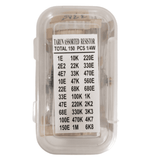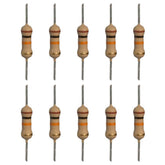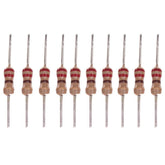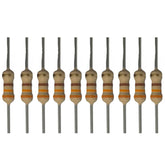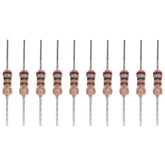Pull-up vs Pull-down resistors
Summary
Are you familiar with pull-up and pull-down resistors? In this engaging blog post, we delve into the world of these essential components in electrical circuits. We start with an introduction to pull-up resistors, exploring when and where they are commonly used. Next, we shift our focus to pull-down resistors and discuss their specific applications. Additionally, we touch upon the concept of internal pull-up/pull-down resistors and their significance. Finally, we reveal the importance of selecting the appropriate pull-up/down resistor values for optimal circuit performance. If you're intrigued to enhance your knowledge of resistors, click here to uncover the secrets of these critical circuit elements!
Introduction:
In electronics, pull-up and pull-down resistors are used to set a default state for digital input or output. These resistors are used to ensure that a digital circuit behaves as expected, even when an input is not connected or is floating. In this blog post, we will discuss the differences between pull-up and pull-down resistors, and when to use them.
Pull-up resistors:
A pull-up resistor is a resistor that is connected between a digital input and a positive voltage source. It is used to set a default logic level of "1" (high) for a digital input when it is not connected or is floating.

For example, when a switch is closed and is connected to the ground, the voltage at the input of the switch is 0V, and the input is read as "0". When the switch is open, the input is not connected and is floating, and the voltage at the input is pulled up to Vcc by the pull-up resistor, and the input is read as "1".
When and where is a pull-up resistor used:
A pull-up resistor is typically used in digital circuits when an input is expected to be at a high logic level when it is not connected or is "floating." This can happen when a switch or button is open, or when a sensor is not providing a signal.
Some specific examples of when a pull-up resistor is used include:
- When a switch or button is used to control a digital input, a pull-up resistor is often used to ensure that the input is high when the switch or button is open.
- In I2C communication, pull-up resistors are often used on the SDA and SCL lines to ensure that the lines are high when no device is actively driving them low.
- In a microcontroller-based system, pull-up resistors are often used on input pins to ensure that the pins are high when no external device is driving them low.

Pull-down resistors:
A pull-down resistor is a resistor that is connected between a digital input and ground. It is used to set a default logic level of "0" (low) for a digital input when it is not connected or is floating.

For example, when a switch is closed and is connected to Vcc, the voltage at the input of the switch is Vcc, and the input is read as "1". When the switch is open, the input is not connected and is floating, and the voltage at the input is pulled down to 0V by the pull-down resistor, and the input is read as "0".
When and where a pull-down resistor is used:
A pull-down resistor is typically used in digital circuits when an input is expected to be at a low logic level when it is not connected or is "floating." This can happen when a switch or button is open, or when a sensor is not providing a signal.
Some specific examples of when a pull-down resistor is used include:
When a switch or button is used to control a digital input, a pull-down resistor is often used to ensure that the input is low when the switch or button is open.
In digital circuits where a sensor is used to detect whether an object is present or not, a pull-down resistor is often used to ensure that the input is low when the sensor is not detecting the object.
In some microcontroller-based systems, pull-down resistors are often used on input pins to ensure that the pins are low when no external device is driving them high.
Internal pull-up/pull-down resistor:
An internal pull-up resistor is a resistor that is built into a microcontroller or integrated circuit (IC) that can be enabled or disabled through software control. It is similar to an external pull-up resistor, but it is located inside the IC, rather than being a separate component that is connected to the input.
When an internal pull-up resistor is enabled, it functions the same way as an external pull-up resistor, pulling the voltage of an input to a high logic level when the input is not connected or is floating. This is useful for ensuring that a digital circuit behaves as expected when an input is not actively being driven by an external device.
The advantage of an internal pull-up resistor over an external pull-up resistor is that it reduces the need for external components and can save space on a circuit board.

In the same way, an internal pull-down resistor is similar in operation instead the pin will supply a low logic level when the input is not connected or is floating. This is to ensure that the logic levels are correctly sent instead of a floating value that might be unpredictable.
Pull-up/down resistor value:
There are two factor which influences the resistor value. Power dissipation is the primary consideration. When the switch is closed, a significant current will flow through the pull-up resistor if the resistance value is too low, heating the component and consuming extra power. This condition is called a strong pull-up. The pin voltage while the switch is open is the second factor. The input voltage may not be sufficient when the switch is open if the pull-up resistance value is too high and the input pin has a significant leakage current. It is known as having a weak pull-up. The typical pull-up resistor value is 1-10 kΩ. Generally, a good starting point when using a switch is 4.7 kΩ.
Conclusion
understanding the differences between pull-up and pull-down resistors is essential for any electronics enthusiast. Pull-up resistors provide a reliable high-voltage reference, ensuring the circuit remains stable when a signal is not actively driven. They find common applications in button inputs, I2C communication, and open-drain devices. On the other hand, pull-down resistors offer a low voltage reference, keeping the signal at ground potential when not actively driven. They are frequently employed in switch inputs and digital logic circuits. Both types of resistors contribute to signal integrity and prevent floating inputs. Additionally, modern microcontrollers often feature internal pull-up/pull-down resistors, simplifying circuit design. The choice of pull-up/down resistor value depends on factors such as the input current, noise immunity, and power consumption. By mastering the application of these resistors, you can enhance the reliability and performance of your electronic circuits. So, why wait? Dive into the world of pull-up and pull-down resistors and unleash the true potential of your circuits today!
If you appreciate our work don't forget to share this post and leave your opinion in the comment box.
Please do check out other blog posts about Popular electronics
Make sure you check out our wide range of products and collections (we offer some exciting deals!)



